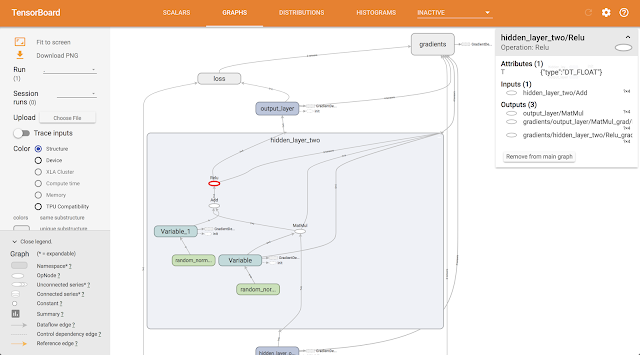Overview
On this article, I’ll write down the note about the example of tf.variable_scope(), meaning how to arrange the graph for TensorBoard.The target code is from the article below.
On a tensorboard, without using namespace, the graph information becomes complex. Namespace will solve the problem and makes it easy to debug.
The example of tf.variable_scope
From the code doc,This context manager validates that the (optional)Partially, I’ll show the example of the usage of tf.variable_scope. By this, on a TensorBoard graph, the part of “data” is separately shown.valuesare from the same
graph, ensures that graph is the default graph, and pushes a name scope and a
variable scope.
# placeholder
with tf.variable_scope('data'):
x_data = tf.placeholder(shape=[None, 3], dtype=tf.float32)
y_target = tf.placeholder(shape=[None, 1], dtype=tf.float32)By the same way, we can set the namespaces for each layer of the neural network.
TensorBoard GRAPHS
The whole code is on the bottom of this article. After executing code, we can get access to TensorBoard by http://localhost:6006. Because I didn’t set the random number seed, the behavior of the loss is not consistent. But the graph part is same. So this time please don’t care.Anyway, the graph is like this.

It is arranged well by namespaces per layers. When you want to check the specific layer, click the layer. You can check the layer.

Whole code
from sklearn import datasets
iris = datasets.load_iris()
print(iris.data[:5])
import matplotlib.pyplot as plt
import numpy as np
import tensorflow as tf
from sklearn import datasets
from sklearn.model_selection import train_test_split
from sklearn.preprocessing import MinMaxScaler
# set random number
seed = 42
tf.set_random_seed(seed)
np.random.seed(seed)
# data
iris = datasets.load_iris()
x = np.array([x[0:3] for x in iris.data])
y = np.array([x[3] for x in iris.data])
x_train, x_test, y_train, y_test = train_test_split(x, y, train_size=0.7)
# normalization
mms = MinMaxScaler()
x_train = mms.fit_transform(x_train)
x_test = mms.fit_transform(x_test)
batch_size = 50
# placeholder
with tf.variable_scope('data'):
x_data = tf.placeholder(shape=[None, 3], dtype=tf.float32)
y_target = tf.placeholder(shape=[None, 1], dtype=tf.float32)
# parameters
with tf.variable_scope('hidden_layer_one'):
W1 = tf.get_variable('weight_1', [3, 6], initializer=tf.random_normal_initializer())
b1 = tf.get_variable('bias_1', [6], initializer=tf.random_normal_initializer())
hidden_1 = tf.nn.relu(tf.add(tf.matmul(x_data, W1), b1))
with tf.variable_scope('hidden_layer_two'):
W2 = tf.get_variable('weight_2', [6, 4], initializer=tf.random_normal_initializer())
b2 = tf.get_variable('bias_2', [4], initializer=tf.random_normal_initializer())
hidden_2 = tf.nn.relu(tf.add(tf.matmul(hidden_1, W2), b2))
with tf.variable_scope('output_layer'):
W3 = tf.get_variable('weight_3', [4, 1], initializer=tf.random_normal_initializer())
b3 = tf.get_variable('bias_3', [1], initializer=tf.random_normal_initializer())
output = tf.nn.relu(tf.add(tf.matmul(hidden_2, W3), b3))
# loss
with tf.variable_scope('loss'):
loss = tf.reduce_mean(tf.square(y_target - output), name='loss')
with tf.name_scope('summaries'):
tf.summary.scalar('loss', loss)
tf.summary.histogram('histogram loss', loss)
summary_op = tf.summary.merge_all()
# optimize
optimizer = tf.train.GradientDescentOptimizer(0.005)
train_step = optimizer.minimize(loss)
with tf.Session() as sess:
# initialize variables
init = tf.global_variables_initializer()
sess.run(init)
# visualize
writer = tf.summary.FileWriter('./graph', sess.graph)
train_loss = []
test_loss = []
for i in range(300):
# index for training
random_index = np.random.choice(len(x_train), size=batch_size)
# prepare data
random_x = x_train[random_index]
random_y = np.transpose([y_train[random_index]])
_, temp_loss, summary = sess.run([train_step, loss, summary_op], feed_dict={x_data: random_x, y_target: random_y})
writer.add_summary(summary, global_step=i)
if i % 50 == 0:
print(str(i) + ':' + str(temp_loss))
if i == 300 - 1:
pred = sess.run(output, feed_dict={x_data: x_test})
pred_list = [x[0] for x in pred]
print(np.transpose(np.array([y_test, pred_list])))